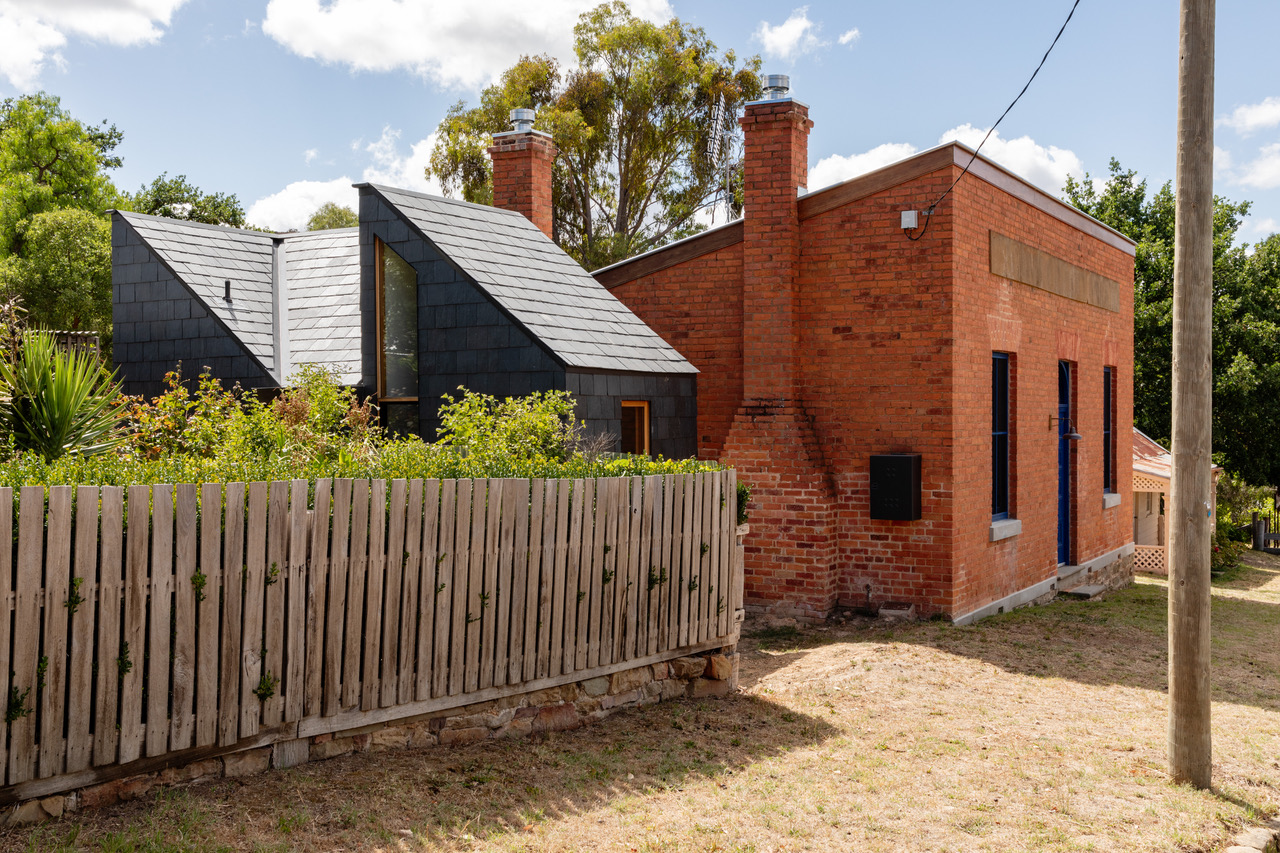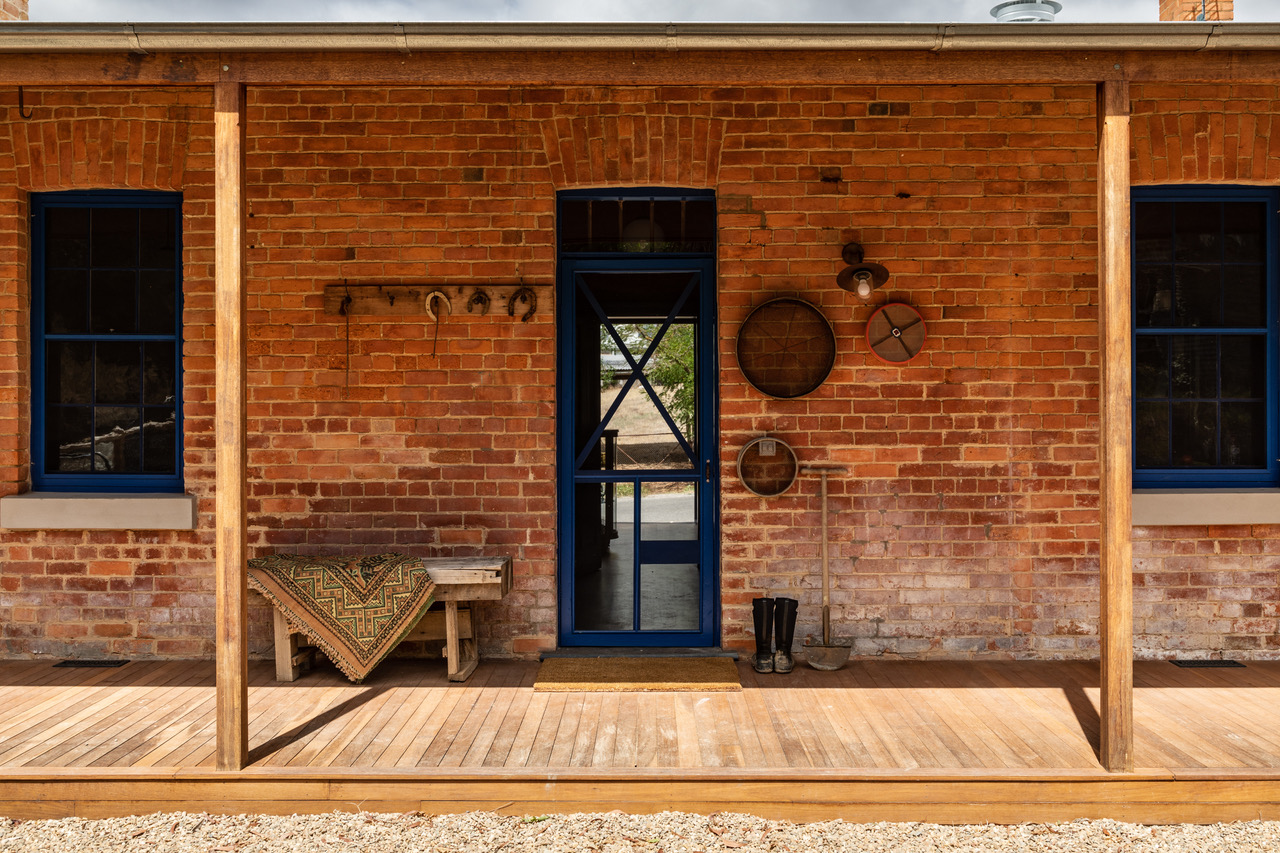Heritage Listing: Heritage Overlay
The Bank at Vaughan project has restored and extended a dilapidated former bank building in the Victorian goldfields. The new interiors evoke earlier finishes, while the new amenities ‘pod’ reflects and reinterprets the form of the bank building. The process of reviving the heritage building and converting it into a home and studio has drawn attention to the quality and value of other historic buildings in the village.
Download a printable version of the Bank at Vaughan Case Study (PDF 2MB).
Significance of the place
The former bank carries three layers of significance for the Shire of Mount Alexander – architectural, historical and social. The building embodies design characteristics and qualities of Victorian commercial buildings, described in fond detail in the local heritage study: “the soft red brick walls, … the timber framed double-hung windows with vertical brick voussoirs [the wedge shaped bricks that form the arches], eight-panelled timber door and arched timber framed fanlight in the rectangular door opening with vertical brick voussoirs, and external brick chimneys with corbelled brick bands.”¹ The historical and social significance relates to the bank’s role in the commercial development of the Victorian gold rush town from the 1850s, and local residents still recognise it as the only early bank in the town.
“The faded beauty of the original colour scheme and wallpaper adorning interior walls have informed the new vibrant blue colour palette, painted to a strong datum and revealing the original crafting of soft red brick and distressed timber lintels. Gold trims punctuate throughout, acting as a foil to the intensity of the colour scheme and referencing the building’s original activity.”
— MARIA DANOS ARCHITECTURE
Opportunities
The ruinous condition of the building presented opportunities that were closely entwined with challenges.
The building’s four rooms – two former bank offices at the west, and the manager’s living room and bedroom to the east – were elegantly proportioned, with potential to become lovely rooms for the new home, and the north facing rear verandah was intact. The peeling walls contained clues to the original interior colour scheme, which informed the new design. Some remnant materials could be removed, cleaned and reused in the extension. The brick walls were solid and durable enough to be stripped, repaired where necessary, and left exposed. The unusual, steep skillion roof provided creative inspiration for the new amenities ‘pod’.
Challenges
The bank was in very poor condition at the start of the project – ceilings had fallen in, floors had collapsed, layers of wallpaper and plaster were peeling off the walls. The building had become a home to rats and other animals. Extensive restoration was required to make these rooms habitable.
“A repository of currency and history, The Bank in Vaughan continues its public and private duties.”
— MARIA DANOS ARCHITECTURE
Approach and outcome
The existing building was treated with great care, while the new work inventively reinterpreted the form, materials and original function of the heritage structure. The original four-room configuration of the heritage building has been maintained without alteration. The two front rooms are now living and bedroom spaces, with the kitchen and another bedroom in the rear rooms, while bathroom and laundry facilities are housed in a slim new ‘amenities pod’ that extends off the kitchen.
Within the bank building, the original wallpaper was very damaged. The wall coverings as well as the original hard plaster were stripped from the walls to reveal the underlying red brick, but the colours are remembered through the striking blue of the new sitting room, kitchen and passage. Gold trim used throughout evokes the former function of the bank. The original iron doors have been retained and restored, complete with exposed rivets, as have most of the original locks and keys. Glass bottles found during the excavation for the extension are displayed within the new home. Baltic pine floorboards retrieved from the bank have become interior wall linings for the bathroom.
The form of the amenities pod is a playful interpretation of the unusually steep skillion roof of the bank, with the slope reversed. The gravitas of the original brick, stone and timber has informed the material choices of the addition – the slate cladding has equivalent robustness and dignity. The interior is designed to be ‘light and uplifting’, an intentional counterpoint to the ‘moodiness and weight’ of the heritage building.
The impact of this project has extended beyond the creation of a new home for the owners. The project showcases the work of local craftspeople – stonemasons, brick restoration specialists, carpenters and locksmiths. It benefited from a project facilitator who brought key local knowledge of specialist trades, coordinated the team and managed the inevitable unforeseen things that occur in the restoration process. The renovation has drawn attention to the quality and value of other historic buildings in the village. In this way, the former civic building is having ongoing public and cultural impact.
Lessons
- The original function of the heritage building is referenced in the design and detailing of its conversion into a new home.
- The form of the new addition is inspired by the heritage building, yet clearly contemporary in its aesthetic and physically separated.
- The addition is modest in scale, ensuring that it doesn’t dominate or overwhelm the heritage building.
- Locating the wet areas in the addition limits the impacts on the heritage building.
- Using skilled local craftspeople familiar with traditional materials and processes supports reuse, repair and restoration (rather than replacing with new). This also helps keep traditional trades alive.
Project team
Project Architect and Interior Architecture: Maria Danos Architecture
Project Facilitator: Debbie Taylor
Builder: Warren Hughes Builders and Renovators
Structural Engineer: Leigh Worn
References
¹Wendy Jacobs, Phil Taylor, Vicki Johnson, and Robyn Ballinger, Shire of Mount Alexander Heritage Study of the former Shire of Newstead, 2000




![18_m3271_0979_©Trevor-Mein-2019-copy-768x512[1]](https://heritagecouncil.vic.gov.au/wp-content/uploads/2021/12/18_m3271_0979_©Trevor-Mein-2019-copy-768x5121-1.jpeg)